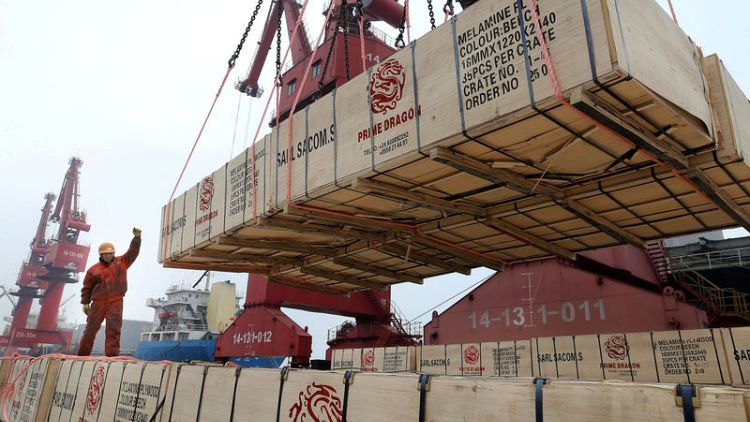By Stella Qiu and Kevin Yao
BEIJING (Reuters) - China's exports unexpectedly returned to growth in January after a shock decline the previous month, while imports fell much less than expected, but analysts said the strength was likely due to seasonal factors and predicted renewed trade weakness ahead.
Investors and policymakers are closely watching to see how quickly activity in China is cooling, or if support measures announced last year are starting to take hold, which could lift some of the gloom hanging over the global economy.
But data on Thursday left many China watchers none the wiser about the current state of the world's second-largest economy, as a March 1 deadline looms for Beijing and Washington to de-escalate their bitter trade war.
January exports rose 9.1 percent from a year earlier, customs data showed, defying economists' expectations for a 3.2 percent drop and a marked turnaround from December's 4.4 percent decline.
Imports fell 1.5 percent, much better than forecasts for a 10 percent slide and narrowing from December's 7.6 percent drop.
That left the country with a trade surplus of $39.16 billion (30.46 billion pounds) for the month.
While the readings appeared positive at first glance, analysts warned that data from China early in the year must be treated with caution due to business distortions caused by the long Lunar New Year holidays, which started on Feb. 4 this year.
Many companies rush out shipments or replenish their inventories of raw materials ahead of the holidays.
"Clearly, the numbers surprised the market on the upside. But given the deceleration of global (factory readings) and weak Korean trade data, it might be pre-mature to conclude that the trade prospect has improved based on the January number alone," said Tommy Xie, China economist at OCBC Bank in Singapore.
"I suspect that the recovery may be partially due to the Chinese New Year effect as this year it is slightly earlier as compared to last year."
Economists had widely tipped that China would see weaker exports early this year.
Factories have reported shrinking overseas orders for months and warehouses in America are packed to the rafters with Chinese goods that retailers stockpiled last year in anticipation of more U.S. tariffs.
Trade has also been faltering globally amid rising protectionism and a loss of momentum in some major economies, most notably in Europe.
Net exports actually dragged on China's growth by 8.6 percent last year, according to Reuters calculations.
Factory surveys have also show weakening domestic orders, and broader economic weakness is taking a toll on both business and consumer confidence. Retail sales during the Lunar New Year holiday rose 8.5 percent from a year earlier, still solid but the slowest pace since at least 2011.
China's economic growth slowed to 6.6 percent in 2018, weighed down by rising borrowing costs and a clampdown on riskier lending that starved smaller, private companies of capital and stifled investment.
THE IDES OF MARCH
Pressure on China's economy could spike if Beijing and Washington do not reach a deal soon to end their year-long trade dispute, which is estimated to have cost both countries billions of dollars already and is taking a growing toll on other export-reliant economies from Asia to Europe.
The U.S. is set to sharply raise tariffs on $200 billion worth of Chinese imports in early March, though President Donald Trump said this week he could let the deadline "slide for a little while" if a deal appears close.
A U.S delegation led by Trade Representative Robert Lighthizer and Treasury Secretary Steven Mnuchin are in Beijing to hammer out a trade agreement.
China's trade surplus with the United States narrowed to $27.3 billion in January, the lowest since May 2018, Thursday's data showed. Exports to the U.S. declined 2.4 percent on-year, while imports fell 41.2 percent.
"Based on the positive signals regarding the U.S.-China trade negotiations, we think it is likely that further tariff hikes will be suspended," Louis Kuijs, head of Asia economics at Oxford Economics, said in a research note.
"An agreement and prolonged tariff suspension would be an obvious plus and imply an upside risk to growth of China's exports and economy more generally."
DEEPER ISSUES FOR CHINA
While a trade deal would boost business confidence and financial markets globally, analysts say it would be no magic bullet for China's broader economic woes.
Some economists predict China's growth rate could drop below 6 percent in the first half of this year before a series of policy measures start to stabilise activity around mid-year.
The latest quarterly business survey by consultancy Oxford Economics showed 38 percent of respondents thought a hard landing in China was a very significant risk to the global economy, almost double the level in the previous poll.
Policymakers have been fast-tracking road and rail projects, cutting import tariffs and urging banks to keep lending to cash-strapped private companies to rekindle domestic demand.
Many analysts also expect sweeping corporate tax cuts to be announced after the annual meeting of parliament in March, but all of the moves will take time to kick in.
Top officials have repeatedly said they will not resort to massive stimulus like that deployed in past downturns, though some analysts believe interest rate cuts are possible if conditions continue to deteriorate and job losses mount.
For a graphic on Trends in China's trade and other major economic indicators, see - http://tmsnrt.rs/2iO9Q6a
(Reporting by Lusha Zhang, Stella Qiu and Kevin Yao; Editing by Kim Coghill)



